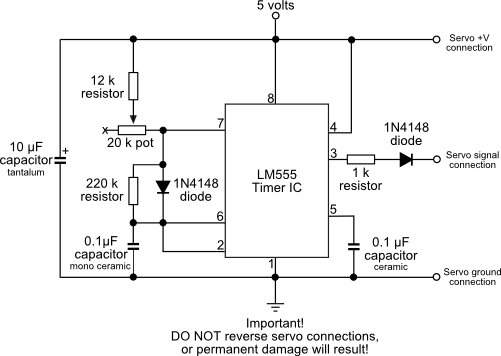Controlling a Servo Via an LM555 Timer IC
You don’t need a microcontroller or computer to control a servo. You can use the venerable LM555 timer IC to provide the required pulses to a servo. The schematic below shows one common approach.

With the components shown, the LM555 chip produces pulses that vary between about 830 μs to 2200 μs, with the pulses repeating about 50 times per second. The LM555 can easily produce pulses of very short and very long duration; depending on the tolerance of the components you use and other factors, there is a chance that the servo may be commanded to operate outside its normal position extremes.
If the servo hits its stop and begins chattering remove power immediately! If you don’t, the gears inside the servo may strip out, and you’ll need to either throw the servo away or replace its gears. Play it safe by not rotating the potentiometer to either extreme.
The capacitor between pin 2 of the chip and ground should be a mono ceramic, polyester (Mylar), or similar capacitor with a tolerance of 10 percent or better. Don’t use a cheapo ceramic disc cap with the typical 20 to 80 percent tolerance. Be sure to connect the tantalum capacitor with the proper polarity, and double-check that you don’t reverse any of the connections to the servo! Swapping the + and ground connections will instantly fry your motor.